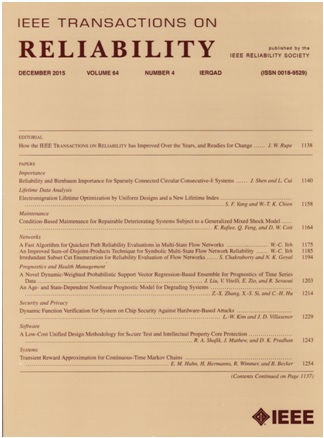认知不确定性网络的信念连接可靠性算法
IF 5.7
2区 计算机科学
Q1 COMPUTER SCIENCE, HARDWARE & ARCHITECTURE
引用次数: 0
摘要
连接可靠性描述了网络中指定节点之间存在路径的能力,已经得到了广泛的研究。然而,由于数据和信息的缺乏,网络及其节点/边缘的状态都具有认知不确定性,这使得现有的连接可靠性评估方法难以接受。为了解决这一问题,本文提出了一种新的基于不确定性理论的连接可靠性:信念连接可靠性。考虑到不同的节点连接要求,我们定义了单节点对信念连接可靠性(SBCR)和多节点对信念连接可靠性(MBCR)两个信念连接可靠性指标。在不确定图的基础上,建立了一个扩展的不确定图来对节点和边的存在性具有认知不确定性的网络进行建模,并提出了基于寻找最可靠连接路径计算SBCR和MBCR的两种算法。最后,通过一个小型网络的对比研究,验证了所提方法的正确性,并以比利时电话区际网络为例,验证了所提网络模型和算法的有效性。本文章由计算机程序翻译,如有差异,请以英文原文为准。
Belief Connection Reliability Algorithm for Networks With Epistemic Uncertainty
Connection reliability, which describes the capability that paths exist between specified nodes in a network, has been widely studied. However, the states of both the network and its nodes/edges have epistemic uncertainty owing to the lack of data and information, which makes existing connection reliability assessment methods unacceptable. To solve this problem, this article proposes a new connection reliability based on uncertainty theory: Belief connection reliability. Considering different node connection requirements, we define two belief connection reliability metrics as single-node-pair belief connection reliability (SBCR) and multi-node-pair belief connection reliability (MBCR). Based on the uncertain graph, an extended uncertain graph is built to model networks whose nodes and edges' existence has epistemic uncertainty, and two algorithms are proposed to compute SBCR and MBCR based on finding the most reliable connection path. Finally, a comparison study on a small network is used to illustrate the correctness of the proposed method, and the Belgian telephone interzonal network is used as a case to indicate the effectiveness of our network model and algorithms.
求助全文
通过发布文献求助,成功后即可免费获取论文全文。
去求助
来源期刊

IEEE Transactions on Reliability
工程技术-工程:电子与电气
CiteScore
12.20
自引率
8.50%
发文量
153
审稿时长
7.5 months
期刊介绍:
IEEE Transactions on Reliability is a refereed journal for the reliability and allied disciplines including, but not limited to, maintainability, physics of failure, life testing, prognostics, design and manufacture for reliability, reliability for systems of systems, network availability, mission success, warranty, safety, and various measures of effectiveness. Topics eligible for publication range from hardware to software, from materials to systems, from consumer and industrial devices to manufacturing plants, from individual items to networks, from techniques for making things better to ways of predicting and measuring behavior in the field. As an engineering subject that supports new and existing technologies, we constantly expand into new areas of the assurance sciences.
 求助内容:
求助内容: 应助结果提醒方式:
应助结果提醒方式:


